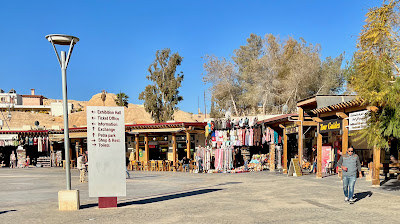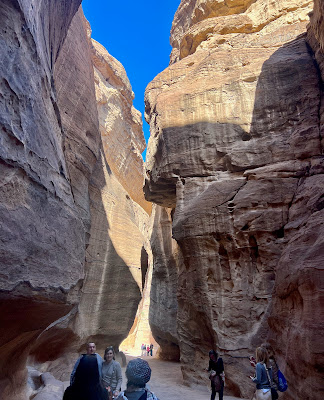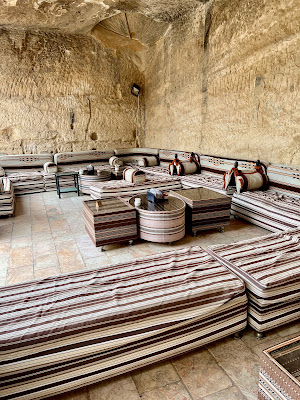Renowned for its charm and ancient cultural heritage, Petra is a reflection of advanced accomplishments of an impressive civilization, the Nabataean Arabs, who perfectly carved the city into its mountains.
 |
| The Treasury at Petra |
Famous for its rock-cut architecture and water conduit system, Petra is also nicknamed the "Red Rose City" because it was crafted out of natural red sandstone. Our visit was the later part of February so weather was very comfortable, in the low 70’s. It can become very hot and miserable during June, July and August with daytime temperatures in the mid to high 80’s.
 |
| Entering Petra Visitors Center |
Petra was considered as the most important strategic location and point of convergence between the Arabian Peninsula to the south, the Levant in the north, to the far country of China and to the heart of Europe.
Petra has been a UNESCO World Heritage Site since 1985. UNESCO describes Petra as "one of the most precious cultural properties of man's cultural heritage". On July 7, 2007 Al-Khazneh (The Treasury) was voted one of the New Seven Wonders of the World.
After three failed attempts to check Petra off my bucket list, February of 2022 would finally find me soaking in the beauty, grandeur and awe of this ancient and mysterious city.
The site has been host to numerous films including Indiana Jones and the Last Crusade, Arabian Nights, Passion in the Desert, Mortal Kombat: Annihilation, Sinbad and the Eye of the Tiger, The Mummy Returns, Krrish 3, Transformers: Revenge of the Fallen, Samsara and Kajraare.
Petra is a symbol of Jordan, as well as Jordan's most-visited tourist attraction. Tourist numbers peaked at 1.1 million back in 2019, marking the first time that the figure rose above the 1 million mark. Unfortunately, tourism was crippled by the COVID-19 pandemic, but has now started to pick up again, reaching 260,000 visitors in 2021.
To spend an entire day exploring Petra one would want to spend an overnight close to the site. The tour operator I selected for my Jordan week was ZAID Tours & Travel.
On our way to our Petra hotel we passed through the town of Wadi Musa, translated as “Valley of Moses”. It is said that Moses passed through the valley with the Children of Israel and brought forth water after stricking a rock with his staff. This historic site is called Ain Musa ("Moses Spring" or "Moses' Well") and is set within a valley that surrounds the ancient city of Petra.
 |
| Said to be the rock struck by Moses to bring forth water |
 |
| Moses' Spring |
 |
| Entrance to Moses' Spring |
Our 2-night accommodation was the Petra Guest House, formerly the Petra Princess Hotel. There are 2 hotels named Petra Guest House. One is located next to the Petra visitor center and the other is located in Wadi Musa. I stayed at the Wadi Musa property. If you are using google maps, you can put in Petra Princess Hotel, Wadi Musa. It is located on a quiet side road with amazing Petra city views.
Our check-in was effortless, beds very comfortable, and water pressure good. All breakfasts and dinners were plentiful with the food locally prepared by the owners family. My room was spacious, had good hot water, air-conditioning, tv, good wi-fi and a hair dryer. The reception area sports a big screen TV with plenty of comfortable seating capacity.
 |
| Breakfast/Dinner seating area |
 |
| Owner Mohammad preparing the meal |
 |
| Lobby area of the hotel |
 |
| My room at Petra Guest House |
The owner, Mohammed, was most helpful in offering lots of tips and recommendations. He even went so far as to take us for a night tour in Wadi Musa. Our viewpoint overlooked the twinkling night lights of Petra.
 |
| Lights of Petra in the background |
After a good night sleep and a very filling breakfast we were ready to tackle Petra. Our guide arrived promptly at 7:45am and we found ourselves standing at the Petra visitors center by 8:00am.
The visitors center contains the ticket office, some modern and clean bathrooms along with several small booths with locals vying for your attention in hopes of selling their goods. Entrance fees to Petra are steep. At today’s rate of exchange the US Dollar equivalent is $70 per person.
 |
| Shops at the Petra Visitor Center |
With map and ticket in hand you will leave the visitor center along an 800 meter (1/2 mile) dirt walk as you make your way to the entrance of The Siq. Our tickets included a one-way horse ride either from the visitor center to the entrance of The Siq or the reverse. My suggestion would be to ride back from The Siq to the visitor center as it’s a much more strenuous walk with an uphill pull from The Treasury back to the emtrance of The Siq.
 |
| Petra Entrance Ticket |
 |
| Petra Map |
 |
| Walking from the Visitor Center to the entrance of The Siq |
 |
| Horses available just past the Visitor Center to ride to The Siq |
THE MAIN TRAIL
This trail is the most visited trail in Petra. It trail starts from the visitor center of Petra through The Siq to The Treasury, proceeds past The Royal Tombs, The Colonnaded Street, and finally The Girl's Palace. The distance covers 4km or about 2.5 miles but there are rest areas and refreshment stops along the way. You also have the option of donkeys or horse drawn carriages.
 |
| The Obelisk Tomb, carved in First Century AD |
THE SIQ
Is the main entrance leading to the city of Petra. It starts at the Dam and ends at The Treasury. Comprised of a split rock with a length of ½ mile, a width of 10 to 40 feet and a height up to 260 feet. Most of the rock is natural with some sculptured by the Nabataeans.
 |
| Dam built at entrance to The Siq |
 |
| Nabataean guards at entrance to The Siq |
 |
| Walking through The Siq |
 |
| Walking through The Siq |
 |
| Walking through The Siq |
 |
| Water sistern inside The Siq |
 |
| Water lines inside The Siq |
 |
| Walking through The Siq |
 |
| Water causeway inside The Siq |
 |
| One of the dams inside The Siq to help with flooding |
THE TREASURY (AL KHAZNA)
The siq opens up onto Petra’s most famous and magnificent façade; The Treasury, or Al Khazna. It is almost 147 feet high and intricately decorated with Corinthian capitals and figures. The Treasury is crowned by a funerary urn, which according to local legend conceals a pharaoh’s treasure. It is believed that The Treasury was probably constructed in the 1st century BC. It consists of two floors with a width of 83 feet and a height of 128 feet.
 |
| First glimpse of The Treasury as I exited The Siq |
 |
| The Treasury |
The purpose of the Treasury is unclear: some archaeologists believed it to be a temple, while others thought it was a place to store documents. The most recent excavation has unearthed a graveyard beneath the Treasury.
 | |
| Locals selling their goods, just past The Treasury |
THE STREET OF FACADES
The name given to the row of monumental Nabataean tombs carved in the southern cliff face that lies past The Treasury and adjacent to the outer Siq. Once you pass The Treasury, The Siq begins to widen gradually until it reaches an open area. On both sides, there are a number of Nabataean burial interfaces decorated with grindstones along with other decorations. Some of these interfaces were destroyed by natural factors. The tomb Anesho is located in the far south of this group and overlooks the external Siq. Anesho was the Minister of Queen Nabatiyeh Shaqilh II, who ruled between 70 and 76 AD as guardians of the throne of her son, Rabil II. These tombs represented courtiers in the middle of the first century AD.
 |
| Street of Facades, Petra |
THE THEATER
Carved into the side of the mountain at the foot of the High Place of Sacrifice, the theater consists of three rows of seats separated by passageways. Seven stairways ascend the auditorium and it can accommodate 4000 spectators. The monument was carved in the mountainside during the reign of King Aretas IV (4BC-AD27). The Romans rebuilt the stage back wall.
 |
| The Theater, Petra |
 |
| The Theater, Petra |
 |
| The Theater, Petra |
THE URN TOMB (THE COURT)
This derived its name from the jar that crowns the pediment. It was probably constructed around 70 AD. It is preceded by a deep courtyard with colonnades on two sides. High up in the facade there are 3 niches which disclose small burial chambers. It was in 446 AD that it was adapted to serve as a Byzantine church.
 |
| The Urn Tomb |
THE SILK TOMB
Located to the north of the Urn Tomb, the tower dates to the first half of the first century AD. The interface measures 35 feet in width and 62 feet in length with a door in the middle, featuring four columns. The name comes from the rich color of the sandstone. It is one of the most dramatically colored tombs in Petra.
 |
| The Silk Tomb, Petra |
THE CORINTHIAN TOMB
The Corinthian Tomb, which lies after the Silk Tomb, was built between 40 and 70 AD. The façade measures 90 feet in width and 85 feet in height. It resembles the Silk Tomb and The Treasury, particularly in the upper part, but is less decorated. There are four water basins in the front and on the side, which were used in the cleansing rituals. There are four rooms inside the tomb, three of which are square-shaped and lie on the left, with one on the right that has an area of 140 square feet.
 | |
| The Corinthian Tomb, Petra |
PALACE TOMB
Located to the north of the Corinthian Tomb, the Palace Tomb measures 160 feet in width and 150 feet in height. The lower part consists of 12 decorated columns and four gates. Above the threshold lie 18 pillars. The four gates of the cemetery lead to four rooms for burial, with some graves carved in the walls. This name was given to the cemetery as it resembles a palace.
 |
| The Palace Tomb, Petra |
THE COLONNADED STREET
The street represents an original Nabataean creation, later refurbished during the period of Roman occupation. It would have been one of the principal shopping streets of ancient Petra. The street was rebuilt in 106 BC with a width of 20 feet. An excavated fossil indicates that there was an older road with a building, lying on its side. On the left of the portico street to the south, there is a set of stairs that leads to the courtyard, which is called the market. This is believed to have been the heart of the city and center of various types of commercial activities and transactions during the third century BC. The street continued to be used throughout the Byzantine period during the fourth and fifth centuries, until the sixth century.
 |
| Temenos Gate and Colonnade Street, Petra |
 |
| Marci and Sharon in front of Hadrian's Gate aka Temenos Gate |
At the end of the road lies the triple gate, which leads to the Temple of Qasr Al-Bint. The street was paved in horizontal and vertical ways in order to facilitate the movement of vehicles as it curved from the middle to allow the draining of water, equipped with a network of channels under the street level. The main gate led to the sacred courtyard known as the Temple of Qasr Al-Bint. Ahead of the entrance to the Gate, there lies a set of stairs that leads to the Temple, and on the other side lies the Black Winged Temple, which is dedicated to the God of Lat and Uzza, who is the mate of the major Nabataean gods.
At the beginning of the Colonnaded Street, The Nymphaeum will be to the right side, which is a semi-circular public fountain near the junction of Wadi Musa and Wadi al-Mataha. Six Nabataean columns decorate the facade. It received water from a tank on the opposite side of the valley. Currently it is shaded by a juniper tree that is 450 years old.
THE MONASTERY
Is one of the largest monuments in Petra, measuring 154 feet wide by 158 feet high. It was built on the model of the Khazna but has niches to house sculptures. A columned portico extends the façade. The interior is occupied by two side benches and an altar against the rear wall. It was used as an ancient Roman dining couch for the meetings of religious associations and dates back to the early 2nd century AD, during the reign of King Rabel II. The hall was reused as a Christian chapel and crosses were carved in the rear wall thus attributing to the name “Monastery”.
 |
| The Monestary, Petra Photo: Public Domain |
We had been told by Mohammad, the owner of the Petra Guest House, that we would not find beer for sale in the town because the entire population is Muslim and it’s a dry city. We were able to sample some local beer just inside the Petra visitor center at The Cave Bar. The cave itself was originally built as a tomb by the Nabataean people who inhabited that area of Jordan between 37 to 100 AD. It also claims to be the oldest cave bar in the world.
Finally after three failed attempts to visit this wonder, I can now check it off my bucket list. Here are just a few remaining pictures that I like. Enjoy!
 |
| Rest area near The Theater |
 |
| Horse drawn carriages for hire |
 |
| My horse ride from the entrance of The Siq back to the Visitor Center |
 |
| Marci and I on our donkey ride |
 |
| The end of The Main Trail before the hike to The Monestary |
 |
| Camels for hire |
 |
| Sights on The Main Trail walk |
 |
| Royal Tomb Gift shop on our walk of the Main Trail |
 |
| Sights on our walk of The Main Trail |
Note: Tipping is not required but is certainly expected.







No comments:
Post a Comment